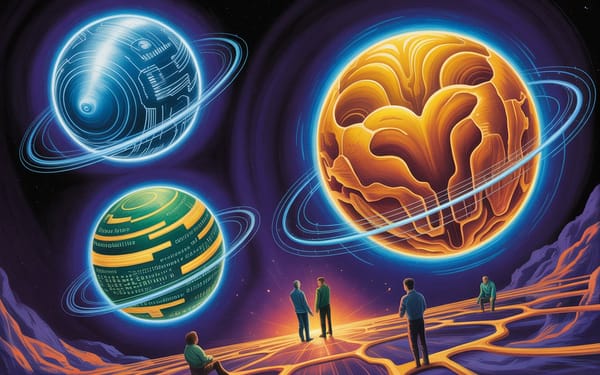How Close Are We? 🔮
Artificial General Intelligence (AGI) enables AI systems to learn and understand any intellectual task that a human can, making it a more evolved form of AI than today's narrow or specific AI. In December 2022, a video was made about the path to AGI, and was my first real exposure to these human and computer-based hallucinations. The video explores what is necessary to get there and what a timeline could look like. Also discusses the common belief that AGI will never happen or not until very far into the future. However, recent advancements in AI and machine learning research papers have been so significant that AGI is no longer just a theoretical concept but already “shows sparks of existence”. However, in actuality, it’s a result of everyone passing around the Hype Pipe. Puff, puff, pass.
$prompt: sparks of artificial general intelligence
The Sparks of AGI
AI and machine learning research papers have grown exponentially to the point of being out of reach for most. Recent breakthroughs and developments have shifted the projected timeline for General AI (AGI). For instance, GPT4 can teach itself to become better through self-reflection, learn tools with minimal demonstrations, and act as an autonomous agent that pursues a multi-step goal without human intervention. Recent developments suggest that the AGI future is already here.
AGI is widely defined, with some discussing human-level intelligence and others arguing for superhuman capacities. In my opinion, the concern should not be AI sentience or consciousness, but rather its capability to exceed human intelligence. Advances demonstrate that logic, memory, and multimodality are not long-term obstacles.
"The greatest shortcoming of the human race is our inability to understand exponential growth."
— Albert Bartlett, Physicist
A graph that shows the number of parameters of different models looks pretty exponential, but this is already a log scale. A straight line on a log scale means exponential growth. This is an exponential graph on a log scale, which is kind of crazy. But parameter growth alone will not reach AGI levels.

Defining AGI
Artificial general intelligence is a hypothetical intelligent agent that can learn to replicate any intellectual task that human beings or other animals are capable of1. It is considered to be strong artificial intelligence and contrasts with weak or narrow AI, which is the application of artificial intelligence to specific tasks or problems2.

Here are some key points about AGI:
- AGI is a theoretical type of artificial intelligence that possesses human-like cognitive abilities3.
- AGI has also been defined alternatively as an autonomous system that surpasses human capabilities at the majority of economically1.
- AGI research activity in 2006 was described as "producing publications and preliminary results”1.
- AGI in computer science is an intelligent system with comprehensive or complete knowledge and cognitive computing capabilities2 .
- Microsoft Research, with help from OpenAI, released a paper on GPT-4 that claims the algorithm is a nascent example of artificial general intelligence (AGI)4.
- As of right now, no true AGI systems exist; they remain the stuff of science fiction2.
- The theoretical performance of these systems is indistinguishable from that of a human2.
- AGI is a very human hallucination3.
- Machines may someday be as smart as people and perhaps even smarter, but the game is far from over5.
While there has been tremendous progress in AI, we are still likely decades away from general-purpose, human-level AI that can understand the true meanings of articles and videos or deal with unexpected obstacles and interruptions5.
The most significant and more significant thing to ponder is how easily the transfer of knowledge from one neural network to another happens right now. A lifetime of learning is transferred in a few milliseconds. However, various fields interpret AGI differently, making a unified definition extremely difficult to create.
AGI is an AI system designed to accomplish tasks that are beyond the capability of humans, to the advantage of humanity.

Challenges to Achieving AGI
Recent advances suggest AGI is closer, yet significant challenges remain. Our knowledge of the human brain is limited; despite its intricate structure, there is still much to learn about its functioning.
AI faces a challenge in achieving one-shot learning, which involves learning from small amounts of data like humans can. Currently, AI requires a large data set for learning, thus more research is required to bridge this gap.
AI and machine learning have made impressive strides, yet creating Artificial General Intelligence (AGI) remains a considerable challenge. A key problem is devising algorithms that learn and apply knowledge from multiple data sources such as sound, visuals, and written texts. Current AI models often only work on one task, such as visual recognition or spoken word translation. They lack the ability to transfer their knowledge outside of the task they are trained on.
Current AI systems lack robustness and adaptability, making them vulnerable to catastrophic breakdowns when exposed to unfamiliar input. To reach AGI, AI must be able to tackle uncertainty, ambiguity, and noise and learn from incorrect responses, much like humans.
AGI requires AI systems to reason hypothetically, think creatively, and make connections like humans. These abilities must be developed to create intelligent AI. Without any explainability, how do we interpret the reasoning that these agents come up with?
Ethical Considerations
AI advancements have ethical implications. Malicious uses of AI - like cyberattacks or autonomous weapons - and the potential to worsen existing biases must be addressed.
AI has the potential to create ethical concerns due to its impact on employment. If AI becomes too advanced, it may replace human workers in many sectors, leading to high unemployment and chaos. We must find solutions to ensure a fair distribution of AI benefits and ways to help workers transition into new jobs as the economy changes.

Token Wisdom
AGI has the potential to drastically transform the world; however, significant advances in AI and machine learning are necessary before this can be realized. It’s essential to consider the ethical and social consequences of AGI and ensure the benefits are evenly distributed.
Before that, we have to be able to show our work. For some of us, we remember when the calculator became commonplace in schools. Some thought to ban them out of fear that these number-crunching robots would soon take over the world and take math teachers’ jobs away.
If the GPT-Calculator tells you the answer is “4”, your math professor will probably want to see the work and doesn’t care that you got the right answer. The professor is more concerned about how we arrived at our solution and the methodologies and processes executed in order to accomplish the task. That’s what’s important and missing in truly understanding the explainability of AI.
However, upon further examination the compute power of a calculator and the innovative thought processes of a human combined made for astoundingly good and accurate test results, the tests just became more difficult. Not unlike the results of many professions that utilize the combination of humans and AI to achieve ground-breaking breakthroughs. We need to maintain a slow and steady balance moving forward.
Always show your work.







Member discussion